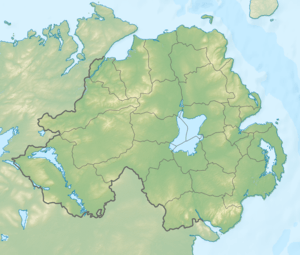Darkley killings
| Darkley killings | |
|---|---|
| Part of the Troubles | |
 | |
| Location |
Darkley, County Armagh Northern Ireland |
| Coordinates | 54°13′43″N 6°26′04″W / 54.2286°N 6.4344°WCoordinates: 54°13′43″N 6°26′04″W / 54.2286°N 6.4344°W |
| Date |
20 November 1983 19:00 (GMT) |
Attack type | Mass shooting |
| Deaths | 3 |
Non-fatal injuries | 7 |
| Perpetrators | Members of the The INLA using the covername "Catholic Reaction Force" |
The Darkley killings (or Darkley massacre) was a gun attack carried out on the 28th of November 1983 at Mountain Lodge Pentecostal Church while a church service of over 60 people was in service, it was just outside the village of Darkley in County Armagh. The Catholic Reaction Force (a group of rogue members of the Irish National Liberation Army) claimed responsibility for the attack citing it as a revenge attack for recent Loyalist paramilitary sectarian killings of Roman Catholic civilians.
Background
There had been a string of killings in the last year or two against Catholic civilians claimed by the Protestant Action Force (PAF) a cover name for the Ulster Volunteer Force (UVF) - the most active Loyalist paramilitary group during the conflict.
On 8 November 1983 Catholic civilian called Adrian Carroll was shot dead by the PAF. Carroll was the brother of a Irish National Liberation Army (INLA) Volunteer killed by the Royal Ulster Constabulary a year earlier.[1] In 1986, four UDR soldiers – the "UDR Four" – were convicted of the murder Adrian Carroll.
Attack
Twelve days after the Adrian Caroll killing the gunmen using the name "Catholic Reaction Force" took action against the church service at Mountain Lodge Pentecostal Church in Dalkey in Armagh (about half of the PAF attacks took place in County Armagh). At the time of the attack there were about sixty people inside the small wooden building. Three members of the church were shot dead as they stood outside the entrance of the building; they were all Protestant civilians Harold Brown (59), David Wilson (44) and Victor Cunningham (39).[2] The gunmen then stood outside the building and sprayed it with bullets, wounding a further seven people.[3] The service was being tape-recorded when the attack took place. On the tape, the congregation can be heard singing the hymn "Are You Washed in the Blood of the Lamb", followed by the sound of gunfire.
Aftermath
A telephone caller claimed responsibility on behalf of the "Catholic Reaction Force". He said it was: "...in retaliation for the murderous sectarian campaign carried out by the Protestant Action Force […] By this token retaliation we could easily have taken the lives of at least 20 more innocent Protestants. We serve notice on the PAF to call an immediate halt to their vicious indiscriminate campaign against innocent Catholics, or we will make the Darkley killings look like a picnic."[4]
The caller named six Catholics who had been killed recently by the PAF & three attacked.
- 24 October 1982: Killing of Catholic civilian Joseph Donegan.[5]
- 25 October 1982: Killing of civilian Sinn Féin member Peter Corrigan.
- 20 November 1982: Killing of Catholic civilian Michael Fay.
- 11 March 1983: Killing of Sean McConnville, a Catholic civilian. Although he was killed by Loyalists in a sectarian attack the PAF or no other Loyalist group claimed the killing but the PAF was suspected.
- 23 April 1983: Bomb attack on the Hole-in-the-Wall pub in Belfast, which was frequented by Catholics. there was no injuries.
- 29 October 1983: Killing of civilian Workers' Party of Ireland member David Nocher.[6]
- 8 November 1983: Killing of Catholic civilian Adrian Caroll.[1]
A week later, INLA leader Dominic McGlinchey gave an interview, where he admitted that one of the gunmen had been an INLA member and admitted supplying him with the gun,[7] but said there was no justification for the attack. The INLA member's brother had been killed by loyalists. McGlinchey explained that the INLA member had asked him for a gun to shoot a known loyalist who had been involved in sectarian killings.[7] However, "clearly deranged by the death of his brother", he "used it instead to attack the Darkley Gospel Hall".[8] McGlinchey said: "This INLA member was a brother of someone who had been killed […] and he must have been unbalanced or something to have gone and organised this killing. We are conducting an enquiry into the whole affair".[4]
Fifteen days after the attack in Darkley on the 5 December the PAF killed INLA Volunteer Joseph Craven (26) as he left the Department of Health & Social Services offices in Newtownabbey, Antrim.[6]
The CRF declared a ceasefire on 28 October 1994.[9]

See also
References
- 1 2 Sutton, Malcolm. "CAIN: Sutton Index of Deaths". ulst.ac.uk.
- ↑ "CAIN: Sutton Index of Deaths". Cain.ulst.ac.uk. 1983-11-20. Retrieved 2015-10-31.
- ↑ "CAIN: Chronology of the Conflict 1983". Cain.ulst.ac.uk. Retrieved 2015-10-31.
- ↑ David McKittrick, Seamus Kelters, Brian Feeney, Chris Thornton, David McVea (2001). Lost Lives: The Stories of the Men, Women and Children who Died as a Result of the Northern Ireland Troubles. p. 963. ISBN 978-1840185041.
- ↑ Sutton, Malcolm. "CAIN: Sutton Index of Deaths". ulst.ac.uk.
- 1 2 Sutton, Malcolm. "CAIN: Sutton Index of Deaths". ulst.ac.uk.
- 1 2 Ireland's Terrorist Dilemma. Martinus Nijhoff Publishers, 1986. pp.104-105
- ↑ Coogan, Tim. The IRA. Palgrave Macmillan, 2002. pp.535-536
- ↑ "Chronology: 1994". www.uhb.fr. Archived from the original on September 27, 2007.